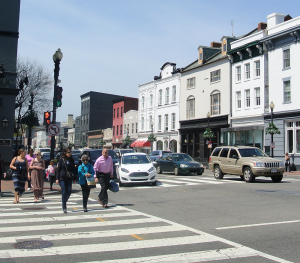
The intersection of Wisconsin Avenue and M Street was named one of the three most dangerous in the District of Columbia in 2013 and 2014.
The District Department of Transportation named the intersection of M Street and Wisconsin Avenue one of the top-three most dangerous intersections in the District for 2013 and 2014, as well as one of the top-three pedestrian crash locations, in a report released on April 1.
The judgment was based on the volume of pedestrian and bicycle collisions and traffic-related incidents in intersections across the District, though specific totals for each intersection were not released. Other intersections at the top of these categories include the intersections of U Street NW at both Ninth and 14th avenues.
Two of the four pedestrian fatalities in Georgetown since 2003 — one in 2005 and one in 2010 — occurred at the intersection of the two major streets. The 2005 fatality was that of Metropolitan Police Department Reserve Officer Joseph Pozell, who was killed while directing traffic. He is memorialized at the intersection.
John Townsend, the manager of public and government affairs at the American Automobile Association’s mid-Atlantic Washington office, ascribed the dangerous conditions to the lack of a Metro stop in Georgetown, the sheer volume of traffic in the area and the large number of pedestrians in the community.
“It’s been problematic for a few years going,” Townsend said.
Additionally, in 2010, the city began allowing automobiles travelling eastbound on M Street to take left turns on Wisconsin Avenue, which can cause conflict and near-accidents between cars trying to beat the light and pedestrians crossing the street when they are not supposed to cross.
Alec Kingston (SFS ’18) said this additional turn is especially problematic.
“All the pedestrians think that when the lights change, it’s their turn — even though there is still a left-hand green signal and the pedestrian light is red,” Kingston said. “People assume that they can just go because the other side of the street is going. I have seen so many people cut it close with cars.”
Georgetown Business Improvement District Transportation Director Will Handsfield emphasized that Georgetown is both a popular retail and tourist destination, saying that each crossing features 20 to 120 pedestrians.
“It needs attention and radical rethinking,” Handsfield said. “There are a lot of conflicts at this one point, and the city needs to do a better job at accommodating the pedestrian traffic, especially at the north-south crossing on the east side of the intersection.”
According to Townsend, the District is taking measures to improve safety conditions at the intersection.
“The city is assigning traffic control officers to help direct the traffic to make it safer for pedestrians,” Townsend said. “It is also important to work with the Department of Public Works and the Department of Motor Vehicles to ensure pedestrian safety.”
Handsfield added that the city is addressing timing of lights at the intersection. On average, pedestrians in Georgetown have only 18 seconds to cross the street.
“The city also has to think about signal timing in the short term,” Handsfield said.
The Metropolitan Police Department, in conjunction with the District’s Department of Transportation, is also looking to install automated traffic enforcement systems as a way to ensure compliance from drivers, discouraging them from stalling in the intersection or running red lights.
Although this innovation will not immediately fix issues, Handsfield stressed that the enforcement systems will improve the situation.
“It means that people will not make the violations over and over,” Handsfield said. “We want to make sure that cars aren’t trying to sneak in among all the pedestrians crossing the street. When we are really busy, it’s not good to have cars breaking the rules.”





















Jim Jackson • Apr 21, 2022 at 8:56 am
Why not incorporate an overhead pedestrian walkway, thus eliminating and avoiding contact of those walking into vehicle traffic.